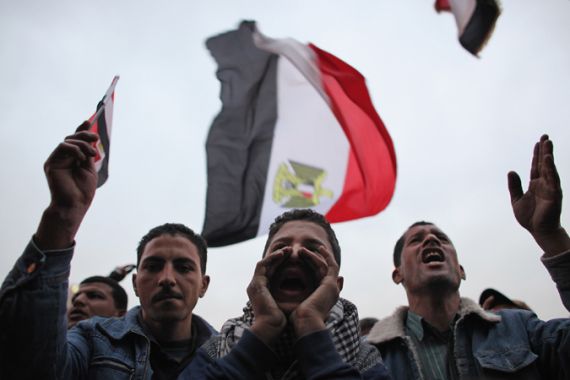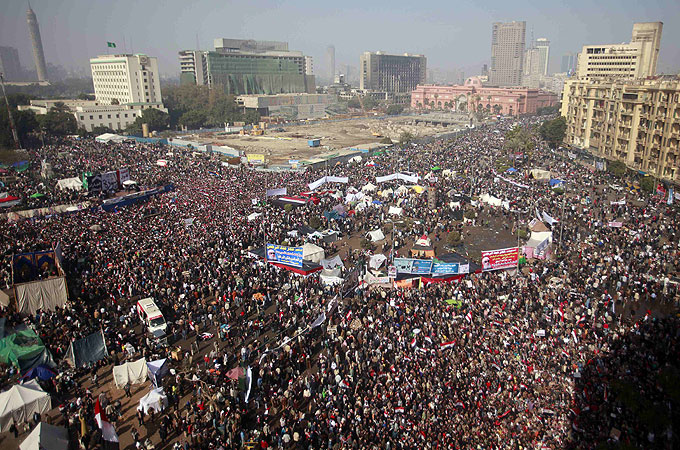January 25 and the republic of Tahrir Square
Tahrir Square, during those 18 days it took to topple Mubarak, turned into an existential ‘republican’ of its own.

 |
| Egyptians mark a full year since their January 25 revolution kicked off in Tahrir Square, where for the eighteen days it took to unseat Mubarak, it was its own ‘republic’ [REUTERS] |
Oxford, United Kingdom – It was a day in history when Cairo reclaimed its name as the “victorious” city. But what was launched on that momentous day at Tahrir Square was more than a revolution for liberty and dignity. It was an act of designing an immaterial (formless) republic, a state of mind and psyche.
It was a day of judgment. Egyptians in spectacular unison set out to dismantle a dysfunctional and decayed republic and for 18 days, creatively founded the “republic of Tahrir Square”, changing the course of an entire region.
Tunisia once again connects with Egypt. Just as the Fatimids left Mahdia to go and flourish and prosper in Egypt, founding Cairo, so did the revolution sparked by Bouazizi. Nowhere in the Arab Middle East was Tunisia’s revolution received more warmly and passionately than in Egypt. The embrace of the flags said it all, and the slogan read: “You first, we next” (antum al-sabiqun wa nahnu allahiqun).
Egypt was already in a revolutionary mood and mode – the mahallah textile strikes and display of defiance, the hereditary bandwagon, corruption and the 2010 rigged elections all combined to bring the day of reckoning, tahrir as it were, emancipation, nearer.
As if Tahrir Square was built for that day, awaiting to receive the deluge of waves upon waves of human crowds all converging on the square to help it live up to its name – liberation square – and measure up to the slogan to “stand tall, you are Egyptian”.
Agency was displayed in multiple colours, prayers, words, shapes, cries, songs, dances and slogans. Perhaps, nothing equals the beauty of such creativity than Egyptians taking over the public square to make it their own and taking charge of time. That is when 31 years of dictatorial urban planning and of regimented timing ceased to have an effect.
When they re-fashioned time and space to suit the moment of liberation, the state was thrown into complete disarray. Never before in the history of humankind was there a Friday of anger. Every Friday, there were the security forces lining up the streets leading up to Al-Azhar mosque and other places where the state kept a watchful eye on citizens it distrusted and controlled via fear. Time was designed to worry about livelihood and the rest of it was apportioned between commuting, working and looking for ways to escape thinking about the things that mattered most at the subliminal level: tahrir from hunger and from tyranny, from Mubarak and from the expanding Gamal club and co.
When Egyptians, like other Arabs, discovered that to topple a state required wresting time and space from the state, they realised they found the antidote to misrule. It was licence for liberators and for liberation, inverting authoritarian orders, resisting in rebellious terms, and in ways no police force in the world was ever trained to sabotage much less handle.
Mikhail Bakhtin comes to mind and so does his notion of the “carnivalesque”.
Humanity at its best was displayed in the square. The square was turned into a space where passion for change, defiance and rediscovering “Egytpian-ness” and “humanness” supplanted the passivity of 31 years when the Egyptians – with unimaginable capacity for gentleness misused by state elites and power-holders.
That public and sustained peaceful display of defiance placed the square into the world’s chronicles of revolution, giving Egyptians a spot in the hearts and minds of billions of global onlookers tuned to the malyuniyyahs (millions) of Tahrir Square. A square that was polyphonic, multi-colourful and vibrant in its contestation of tyranny, day after day simulating the downfall of the Pharaoh.
The world watched and imbibed the unfolding and sweeping revolutionary ethos that was to spread further afield. Without Tahrir, Libya would not have risen in rebellion, nor would have Syria and Yemen. In large part, the square was the second birthplace of the Arab Spring.
Rebellion was integral to tahrir to the moment when the world stopped to watch Egypt reinvent itself. Rebelling is good. Every myth, every ethic and every policy in Egypt and the rest of the Arab world was always geared towards oppressing even the thought of rebellion much less playing it out so openly, defiantly and collectively in the hub of the Pharaoh’s city, close to his mugamma and in full view of his uniformed and un-uniformed guardians. The ‘ghalabah‘ (down-trodden) complex so entrenched in Egypt was smashed with every song, dance, amongst other endless carnivalesque techniques for overthrowing tyranny. The Egyptians did this on their terms, through re-ordered time and space.
They stopped. The state’s time froze on that day and over the following 18 days. A different clock started ticking away, tahrir time was on. Space too was changed. The Square where no one dared crossing was returned to the people. That was the fatal blow to the Trojan horse of Pharaonic rule. The security apparatus was beaten in its own game: Classically, they guarded TV and the structures symbolic of officialdom.
Intelligent protest: That is the answer to what kind of protest Egyptians staged in the square. Egyptians dismissed the state when they shifted the focus of protest, attention and creative protest to a central square. It escaped the attention of security planners. More or less, the goal posts were changed, and with it the terrain on which Egyptians did draw the lines of battlefield with Mubarak and co. That was partly how they triumphed.
They were able to open up a space of protest and a geography of solidarity against tyranny. It was the onset of a different project: A public arena for reclaiming popular sovereignty and enacting peoplehood.
Republic is the word. They disowned the rules of engagement which condemned them to denizenship. That they did creatively and intelligently. The republic they founded was a state of mind and psyche – for which no police force or state has a plan. A republic in a space impossible to reclaim by any material means of state control and penetration. It was immaterial running to a time of its own, time made out of values no state-holder in Mubarak’s state could respond to.
That republic will live on – always lurking to bring the Egyptians back to a square of no particular dimensions to resist, if need be. The other republic materially being today designed and populated with parliamentarians, officialdom and state offices matters. But it matters even more if the republic that was Tahrir Square on January 25 for 18 days remains a beacon of inspiration and hope.
Dr Larbi Sadiki is a Senior Lecturer in Middle East Politics at the University of Exeter, and author of Arab Democratisation: Elections without Democracy (Oxford University Press, 2009), The Search for Arab Democracy: Discourses and Counter-Discourses (Columbia University Press, 2004) and forthcoming Hamas and the Political Process (2012).
The views expressed in this article are the author’s own and do not necessarily reflect Al Jazeera’s editorial policy.
